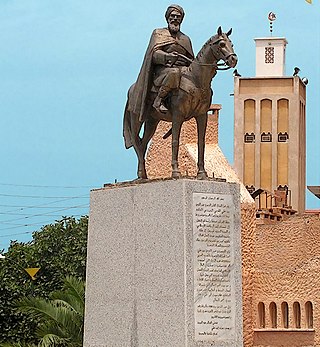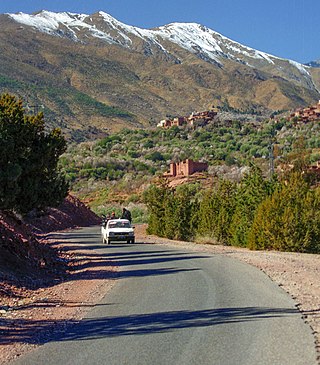
The Almoravid dynasty was a Berber Muslim dynasty centered in the territory of present-day Morocco. It established an empire that stretched over the western Maghreb and Al-Andalus, starting in the 1050s and lasting until its fall to the Almohads in 1147.

Much of the history of Algeria has taken place on the fertile coastal plain of North Africa, which is often called the Maghreb. North Africa served as a transit region for people moving towards Europe or the Middle East, thus, the region's inhabitants have been influenced by populations from other areas, including the Carthaginians, Romans, and Vandals. The region was conquered by the Muslims in the early 8th century AD, but broke off from the Umayyad Caliphate after the Berber Revolt of 740. During the Ottoman period, Algeria became an important state in the Mediterranean sea which led to many naval conflicts. The last significant events in the country's recent history have been the Algerian War and Algerian Civil War.
The history of human habitation in Morocco spans since the Lower Paleolithic, with the earliest known being Jebel Irhoud. Much later Morocco was part of Iberomaurusian culture, including Taforalt. It dates from the establishment of Mauretania and other ancient Berber kingdoms, to the establishment of the Moroccan state by the Idrisid dynasty followed by other Islamic dynasties, through to the colonial and independence periods.

The Almohad Caliphate or Almohad Empire was a North African Berber Muslim empire founded in the 12th century. At its height, it controlled much of the Iberian Peninsula (Al-Andalus) and North Africa.

Medieval Muslim Algeria was a period of Muslim dominance in Algeria during the Middle Ages, spanning the millennium from the 7th century to the 17th century. The new faith, in its various forms, would penetrate nearly all segments of society, bringing with it armies, learned men, and fervent mystics; in large part, it would replace tribal practices and loyalties with new social norms and political idioms.

Abd al Mu'min was a prominent member of the Almohad movement. Although the Almohad movement itself was founded by Ibn Tumart, Abd al-Mu’min was the founder of the ruling dynasty and creator of the Almohad empire. As a leader of the Almohad movement he became the first Caliph of the Almohad Empire in 1133, after the death in 1130 of the movement's founder, Ibn Tumart, and ruled until his death in 1163. Abd al-Mu'min put his predecessor's doctrine of Almohadism into practice, defeated the Almoravids, and extended his rule across Al-Andalus and as far as Tunis in Ifriqiya, thus bringing the Maghreb in North Africa and Al-Andalus in Europe under one creed and one government.

Abū Yūsuf Yaʿqūb ibn Yūsuf ibn Abd al-Muʾmin al-Manṣūr, commonly known as Yaqub al-Mansur or Moulay Yacoub, was the third Almohad Caliph. Succeeding his father, al-Mansur reigned from 1184 to 1199. His reign was distinguished by the flourishing of trade, architecture, philosophy and the sciences, as well as by victorious military campaigns in which he was successful in repelling the tide of the Reconquista in the Iberian Peninsula.

Yusuf ibn Tashfin, also Tashafin, Teshufin, was a Sanhaja leader of the Almoravid Empire. He cofounded the city of Marrakesh and led the Muslim forces in the Battle of Sagrajas.

Abu Abd Allah Amghar Ibn Tumart was a Muslim Berber religious scholar, teacher and political leader, from the Sous in southern present-day Morocco. He founded and served as the spiritual and first military leader of the Almohad movement, a puritanical reform movement launched among the Masmuda Berbers of the Atlas Mountains. Ibn Tumart launched an open revolt against the ruling Almoravids during the 1120s. After his death his followers, the Almohads, went on to conquer much of North Africa and part of Spain. Although the Almohad movement itself was founded by Ibn Tumart, his disciple Abd al-Mu'min was the founder of the ruling dynasty and creator of the Almohad empire.
This is a timeline of notable events during the period of Muslim presence in Iberia, starting with the Umayyad conquest in the 8th century.

The medieval era of Tunisia began with what would eventually return Ifriqiya to local Berber rule. The Shia Islamic Fatimid Caliphate departed to their newly conquered territories in Egypt leaving the Zirid dynasty to govern in their stead. The Zirids would eventually break all ties to the Fatimids and formally embrace Sunni Islamic doctrines.

Almohad doctrine or Almohadism was the ideology underpinning the Almohad movement, founded by Ibn Tumart, which created the Almohad Empire during the 12th to 13th centuries. Fundamental to Almohadism was Ibn Tumart's radical interpretation of tawḥid—"unity" or "oneness"—from which the Almohads get their name: al-muwaḥḥidūn (المُوَحِّدون).

Tinmel is a small mountain village in the High Atlas 100 km from Marrakesh, Morocco. Tinmel was the cradle of the Berber Almohad empire, from where the Almohads started their military campaigns against the Almoravids in the early 12th century.

The history of Marrakesh, a city in southern Morocco, stretches back nearly a thousand years. The country of Morocco itself is named after it.
Fannu bint Umar ibn Yintan was a princess and a Commanding officer of the Almoravid dynasty. In the guise of a man, wearing armour she participated in the defense of the citadel of Marrakesh during the Almohad conquest of the city in 1147.

The Minbar of the Kutubiyya Mosque is a minbar produced in Cordoba, Spain, in the early 12th century by order of the Almoravid amir Ali ibn Yusuf. The minbar was commissioned for the main mosque of Marrakesh, the Almoravid capital in Morocco. After the Almohad conquest of Marrakesh in 1147, the minbar was moved to the new Kutubiyya Mosque built by Abd al-Mu'min. It remained there until 1962, when it was moved into storage and then to the El Badi Palace for public display, where it remains today. Made primarily of wood and decorated with a variety of techniques, the minbar is considered one of the high points of Moorish, Moroccan, and Islamic art. It was enormously influential in the design of subsequent minbars produced across Morocco and the surrounding region.

The Almoravid dinar was a gold dinar coin minted under the Almoravid dynasty in the Maghreb and Iberia. The mints that produced them were supplied by the West African gold mines south of the Sahara desert. The Almoravid dinars circulated widely beyond the reach of the empire; the Christian kingdoms of Iberia called them "marabotins" and "maravedís".
The Battle of al-Buhayra was a battle between the Almoravid and the Almohad armies in May 1130 CE just outside Marrakesh, Morocco.
The siege of Marrakesh was led by the brothers of Ibn Tumart, Isa and Abd al-Aziz who rebelled against Abd al-Mu’min and sieged Marrakesh.
The Almohad expedition to Dukkala was led by Abd al-Mu'min against tribesmen of Dukkala.












